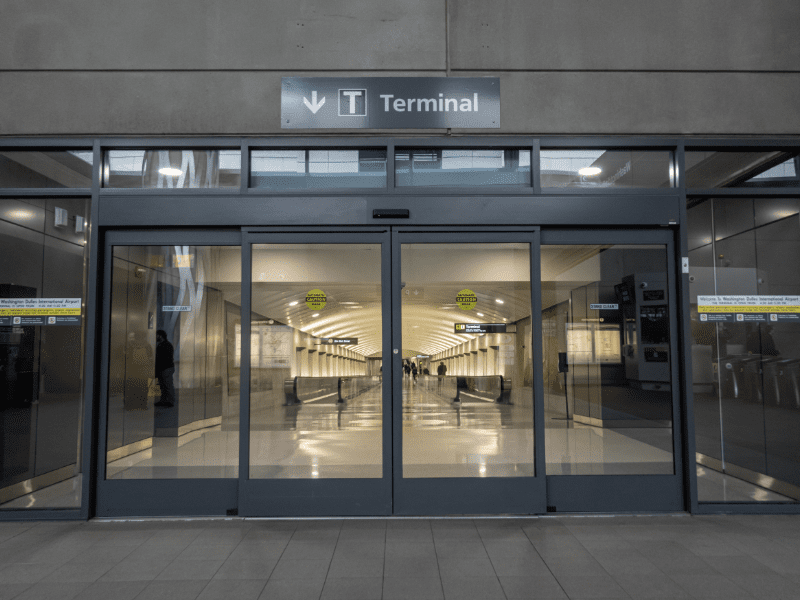Airports manage millions of passengers each year, and with this heavy footfall comes a big responsibility – to maintain strict safety standards. Every entrance is a potential risk if not properly controlled, but technology can help balance passenger comfort with the need for vigilance.
Among these technologies is the automatic sliding door an often overlooked tool in the security arsenal. It’s a key player for airport security, airport door security and airport entrance security.
In this blog, we’ll explore why the automatic door is an essential entry solution for airports. We’ll look at how sliding doors improve protection, and why both airports and businesses benefit from these advanced entrance systems.
How automatic sliding doors support airport security
Automatic sliding doors create controlled access points, opening only when authorised and closing quickly to reduce risk. This offers smooth passenger flow and at the same time, limits opportunities for unauthorised entry.
Our automatic sliding door system is designed for continuous operation in high-traffic areas. Providing low noise, strong safety standards, and the ability to adjust speeds and timings – it’s a powerful tool that supports airport security teams. Features like these make it great for terminals where reliable equipment needs to adapt to demand.
For busy airports, these systems help staff maintain vigilance without slowing passengers down. It’s a great balance between safety and convenience – something at the heart of airport security.
The role of automatic doors in airport entrance security
An automatic door at the terminal entrance is often the first contact a traveller has with the airport. It welcomes guests but also acts as a key checkpoint. With integrated controls, the door can restrict entry during security alerts or emergencies.
Plus, automatic doors are accessible for passengers with luggage, pushchairs or reduced mobility. This combined accessibility and security improves the overall passenger experience. At the same time, the entrance is monitored and reinforced, showing how airport entrance security needs reliable automatic door systems.
Sliding door technology and its role in airport door security
Sliding doors are a practical design for busy airports. Unlike swing doors, they don’t require extra space, allowing airports to maximise floor layouts and maintain clear sightlines for security staff.
Modern sliding doors include features like one-way access, partial opening, and locked settings. These adaptive functions make it easy to switch from normal operations to restricted access when needed.
Then there’s integration with biometric scanners and CCTV, strengthening airport door security further. By pairing sliding door systems with surveillance and access controls, airports create layered protection that is flexible and efficient.
Benefits of automatic sliding doors versus manual doors in airports
So, airports could use manual doors, but they come with some obvious challenges. Let’s run through some: manual doors can be left open, creating risks, and they also slow down passenger flow during peak times.
Automatic sliding doors eliminate these hurdles, opening and closing consistently. They reduce human error, improve hygiene by eliminating touchpoints, and save energy by limiting draughts. These systems also respond better during emergencies, where rapid closing or locking can secure areas instantly.
Choosing sliding doors over manual alternatives allows airports to boost safety and efficiency.
Features of automatic sliding door systems
Here at EA, we supply both bespoke installations and retrofit kits. Many of our models offer over 30 programmable settings, from opening speed to wait times. Its adaptability means the system works in busy environments like airports.
For more complex entrances, we also produce curved sliding doors. If you’re looking to maintain style whilst delivering the same strength and performance as standard models, this is a great choice. Wind tunnel testing has shown their stability under pressure, which is vital for exposed airport locations.
Business entrance security: lessons from airports
Airports are some of the most demanding environments, but businesses of all sizes face similar challenges, such as balancing access with protection. An office or retail store benefits from an automatic door too, creating a welcoming impression and maintaining control in tandem.
Plus, sliding doors can link with staff access cards, visitor systems, and fire safety controls. Just like in airports, the door is both a convenience and a security tool. Companies that adopt these systems gain improved efficiency, reduced energy costs and stronger security.
The future of smart automatic sliding door systems in airports
Technology is advancing, and this goes for access control, security and entrance solutions. Tomorrow’s automatic sliding doors will integrate more deeply with artificial intelligence, IoT devices, and predictive monitoring, allowing airports to spot unusual patterns and respond faster.
Imagine a sliding door that locks automatically when a potential threat is detected, or one that adjusts flow depending on passenger traffic in real time. These features are becoming reality, soon to make airport door security smarter, stronger and more adaptable.
Get the right automatic sliding door for your airport
Automatic sliding doors are no longer just an architectural choice, they’re key for airport security. By combining reliable technology, flexible settings and seamless integration with wider systems, this automatic door helps airports achieve a secure and efficient environment and simultaneously support improved customer experience.
Ready to install an automatic secure entrance solution in your busy terminal? Chat to our team about which of our doors is the right fit.





















